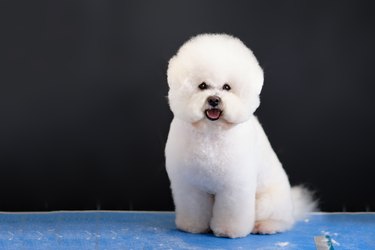Dogs look beautiful after a visit to the groomer, but the white fur around their mouth can quickly become stained due to various factors. Fortunately, with regular face cleaning, especially after meals and drinks, your pup's mouth will stay clean and fresh.

Stains around the eyes and mouth may affect dogs of all breeds. However, they are more noticeable in white-colored dog breeds, such as bichons, Malteses, white poodles, or Westies. To keep your dog looking their best, regular washing, wiping, and drying of the white dog fur around the mouth will help keep stains at bay and prevent any clumps of food from building up and ruining your dog's appearance.
Video of the Day
Video of the Day
Causes of a dog's brown saliva stains
Stains around a dog's mouth are typically reddish-brown due to substances found in saliva and tear ducts called porphyrins. Dogs constantly salivate, so oxidation along with the pH of their saliva contribute to the problem. Artificial colorants in food and treats can stain the area around your dog's mouth, as can some minerals in tap water.
In addition, the stains can result from an accumulation of bacteria or yeast cells, which also contribute to the formation of tear stains in white dogs. That's because bacteria and yeast flourish in moist, warm areas, such as the fur around the mouth. If the stained area around the mouth has a foul smell, the dog may have an infection that requires treatment.
How to remove brown stains around a dog's mouth
To tackle stubborn stains on the white fur around your dog's mouth and dog tear stains, start by bathing your dog with a whitening shampoo for dogs. These shampoos are specifically designed to remove stains and visibly whiten fur.
During the bath, apply the whitening shampoo to the area around the mouth. Allow it to sit for a few minutes before rinsing the area and drying it thoroughly. Between baths, use a pre-moistened pet wipe or baby wipe daily to maintain the cleanliness of the fur around the mouth.

Homemade dog mouth stain remover
Using whitening shampoo regularly to wash the fur around the mouth can be very effective. If you want to try a safe home remedy for staining, you should be able to use items you already have in your home.
- Use diluted 3 percent hydrogen peroxide to clean stained fur around your dog's mouth. Dampen a paper towel with equal parts of 3 percent hydrogen peroxide and warm water. Use the damp cloth to clean the fur around the mouth. The peroxide is safe for your dog's coat and will help bleach away stains.
- Use a diluted boric acid solution to remove stains on white fur. Mix together 1 tablespoon of boric acid and 1 cup of distilled water. Bring the solution to a boil and then allow it to cool to room temperature. Mix well and apply it to the area around your pooch's mouth. Allow the hair to dry and brush the fur thoroughly. Boric acid acts as an antiseptic and inhibits the growth of yeast cells and bacteria.
Keep dog fur dry to stop stains
Keeping the fur on your dog's face dry is one of the best ways to prevent staining. Daily dog grooming and maintenance will help with this.
- Wipe your dog's muzzle with paper towels or a soft washcloth two to three times a day. Wiping your dog's mouth dry frequently will prevent yeast and bacteria from flourishing in the first place and help prevent white fur staining.
- Use dry dog shampoo. Not only does dry dog shampoo keep the fur around the mouth dry but it can also keep a dog's white fur white.
- Rub cornstarch into the fur around the mouth. Cornstarch helps to absorb excess oil and has the added benefit of removing odors. Brush your dog's fur thoroughly and then rub some cornstarch into the affected area. After about 10 minutes, brush out the cornstarch until the fur feels soft again.
- Seek veterinary advice. If keeping the area dry doesn't help, take your dog to the veterinarian. Excessive staining can be a symptom of an underlying illness, such as periodontal disease, yeast or bacterial infections, trauma, or cancer.

Prevention of stains around a dog's mouth
Dog food containing artificial colorants may contribute to the discoloration of the hair around your dog's mouth. While wiping your dog's mouth after each meal can help reduce staining, switching to a food with no artificial colors may stop the stains. You'll also want to filter your dog's water or give them only distilled water.
Invest in ceramic or stainless steel food and water bowls if you currently use generic metal or plastic ones. Plastic can harbor bacteria, and certain metals other than stainless steel may get rusty over time, leading to mouth stains.
The bottom line
Dog owners should know that staining of the white fur around a dog's eyes and mouth is common. In some cases, it may be caused by infections or illness, so it is recommended that you discuss the problem with your veterinarian. Good daily grooming routines can help prevent or reduce staining. Products such as dry shampoos or safe, homemade alternatives can whiten the fur after staining.